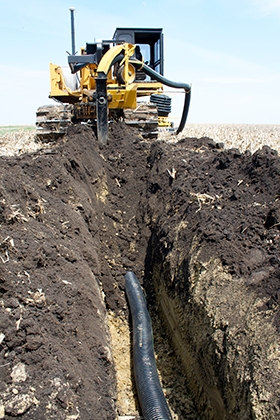
News
SDSU Extension develops drainage calculators
March 4, 2015 By SDSU iGrow
 Courtesy of iGrow. South Dakota State University (SDSU) Extension recently released web-based drainage calculators for tile drainage and sub-irrigation design.
Courtesy of iGrow. South Dakota State University (SDSU) Extension recently released web-based drainage calculators for tile drainage and sub-irrigation design.March 4, 2015, Brookings, S.D. – South Dakota State University (SDSU) Extension recently released web-based drainage calculators for tile drainage and sub-irrigation design.
Contractors and farmers can access these calculators at www.iGrowDrainage.org. The calculators are compatible with a variety of devices allowing for in-field use.
“For years farmers and contractors have asked our team to develop calculators they could use in the field because several calculations are needed when designing drainage systems on agricultural land,” explained Chris Hay, SDSU extension water management engineer.
To meet this demand, Hay and his team took research-based calculations and designed several easy-to-use calculators which address common drainage design calculations to provide farmers and contractors with in-field data they need. “These are equations that we as engineers like to play around with but aren’t always the easiest to use. The calculators are designed to make it easy to get quick answers so they can get the job done right,” Hay said.
The calculations Hay references provide research-based guidance to boost productivity and minimize downstream impacts on everything from drain spacing and pipe sizing, to subirrigation and lift station design.
“When tiling, the calculations need to be correct in order for the drainage system to meet the farmer’s goals and function properly. Once you put the pipe in the ground, the goal is that it will last 50 to 100 years or more without issues,” Hay said.
Tiling is designed to drain excess moisture off fields that have reached their holding capacity. “Many soils in the Upper Midwest do not drain well because of glacial influence,” Hay explained. “Many fields sit on top of layers of glacial till or other restrictive layers that can limit natural drainage.”
Demand for tile drainage is up in portions of South Dakota where excess field moisture can delay or prevent planting, explained Nathan Utt, agricultural engineer with Ecosystem Services Exchange. “There is an increase in drainage installation and a growing number of people who are doing the installation. Not only contractors, but farmers and other landowners who are installing their own drain tile,” said Utt who has been working with agricultural drainage since 2007 and as an engineering consultant in the field for three years.
“These calculators are helpful because they provide accurate numbers for factors like optimum drainage spacing, which is critical to system performance as well as minimizing system cost,” Utt said.
The calculators were developed in cooperation with University of Minnesota Extension. To learn more and access the calculators, visit the iGrow Drainage website.
Print this page